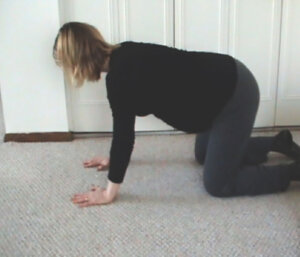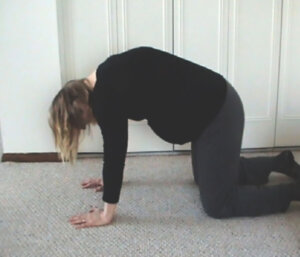The Pelvic Tilt, done with the mother on her hands and knees, is good to relax the lower back after a long day. This gentle rocking exercise keeps the pelvic joints loose too.

In addition to being a great relaxation method, I believe there is a way to use the Pelvic Tilt to help with fetal positioning–so long as it’s done when the baby is trying to rotate to the anterior, whether in pregnancy or labor.
To do the Pelvic Tilt, you need to be on your hands and knees. Lift your lower back up towards the ceiling. (You can imagine that an invisible rope is helping you lift your lower back.) Don’t arch your shoulders, as that’s not the part that counts.

Now straighten your back. Don’t dip your lower back like a swayback horse, as that might strain your muscles in pregnancy. Switch from curling your lower back to straightening it rhythmically. Put music on if you’d like.
Do this 40 or so times. When you’re finished, be sure to get up slowly so you don’t get a head rush.
To allow the pelvic tilt to be most effective, it is recommended that the mother have her abdominal ligaments and pelvic joints worked on. This step is more important for first-time mothers, mothers beginning very late in pregnancy, and mothers who have had interventions in a previous birth due to the baby’s position or length of labor.
Please note: This activity is only supportive, however, and shouldn’t be considered a main activity to rely on for improving fetal position (i.e. flipping a breech, turning an OP baby to OA, etc.).
You shouldn’t do the pelvic tilt if your wrists are too sore or your knees hurt. To help your wrists, see if you can support yourself by leaning over an exercise ball or the back of a couch. If your knees are sore, try putting a pillow or a soft blanket under them.
You could also try this while side-lying, standing, or on your back with your knees bent.
Put a tightly rolled hand towel under your palms by the base of your thumb to set your palms in a more comfortable angle.
Some women will do a “Downward Dog” yoga position after doing “Cat-Cows” (the yoga variation for Pelvic Tilts). If you want to do these, use a yoga mat.
For additional education to even further enhance your pregnancy and labor preparation, shop our extensive collection of digital downloads, videos, DVDs, workbooks, and more.